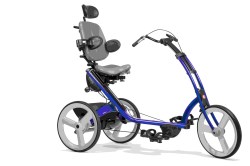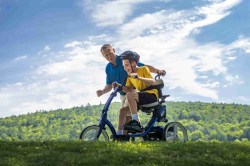Center SATR LLP is an dealer in the Republic of Kazakhstan of the following companies:
RECK-Technik GmbH&Co.KG (Germany), Rehab and Medical Ltd (UK), Conmet Holding (Russia), Attainment Company (США), Edu-consulting International Ltd (Israel), PATH MEDICAL GmbH (Germany), MED-EL (Austria), Oticon (Denmark), Chinesport S.p.A. (Italy), Entertainment Robotics (Denmark), Freedom Scientific (США), Optelec (Netherlands), Index Braille (Sweden), Elite Group LLC (Russian Federation, Moscow), Electronics Laboratory "ElecZhest" LLC (Russian Federation, Moscow), HumanWare Group (Canada).
If you have any questions regarding the products and services, please contact the sales department: +7 727 3958511 info@satr.kz
Orthopedic bicycle, USA
Rehabilitation tricycles for the disabled are designed to teach walking skills by developing knee flexion and extension in the sequence in which this occurs when walking. And also, for independent movement of a user with movement disorders at high speed and over long distances. For children of all ages, as well as adults with cerebral palsy and other musculoskeletal diseases. Riding a bicycle gives the user not only pleasure, but also good physical exercise. While riding, all muscle groups work. These muscles perform very important and necessary circular cyclic movements, during which they stretch, bend and tense. In addition, the balance of the torso is stabilized. Cycling with peers makes the treatment process interesting and more effective, motivates the user, develops social skills and communication.
A bicycle for special children and adults should have an easy ride and a low gear. Firstly, it is safe, and secondly, the golden rule of mechanics works - you lose in speed, you gain in strength. A user, even with very weak muscles, can pedal and move on the adaptive one. If the user cannot hold his back and sit firmly in the saddle, he must be securely fastened to the vertical backrest.
A bicycle for the disabled should not tip over, its center of gravity should be as low as possible and the distance between the rear wheels as wide as possible.
Rehabilitation tricycles with foot drive "Rifton" (Rifton, USA) are specially designed and ideal for people with disabilities, including those with cerebral palsy, children and adults of any age and size.
The Rifton bicycle was originally designed for disabled children and adults with cerebral palsy with severe functional impairment, for patients who cannot ride any adapted bicycle adapted for the needs of disabled people.
Advantages of the Rifton bicycle over analogues
The bike has an exceptionally easy ride thanks to large non-crumple wheels and a single-axis principle of wheel movement with at the same time increased stability. The drive is carried out on one rear wheel, which ensures that the structure does not break when cornering with the outer wheel. As a result, people with very severe disabilities can use a bicycle. Also, thanks to the single-wheel drive, it is possible to widely space the rear wheels for stability and safety.
The frame includes long pedals (for the entire foot) with rear and front removable cables to hold the pedals in the correct position in all phases of movement, including during passive movement with the help of an accompanying person; the cables provide cyclic reciprocal flexion-extension in the ankle joints, similar to what happens when walking; and “sandals” for fastening the feet, the sandal straps with Velcro securely secure the feet in all planes, preventing displacement.
Very easy start of movement, impossibility of overturning the bike for a user with hyperkinesis.
The stable platform allows you to easily and safely place both an adult and a disabled child on the bike.
The low frame, adjustable handlebars and a special torso support system with removable side restraints make it easy to get on and off the bike.
What does cycling provide from a therapeutic point of view?
Motivation
Development of muscle strength
Development of the vestibular apparatus
Developing Spatial Awareness
Development of leg movement skills for subsequent learning to walk
Prevention of contractures, development and maintenance of joint flexibility
Maintaining correct posture and muscle tone of the upper and lower extremities
Developing trunk, shoulder and head control
Designed to teach walking skills by developing flexion and extension of the knees in the sequence in which this occurs when walking. And also, for independent movement of a user with movement disorders at high speed and over long distances





